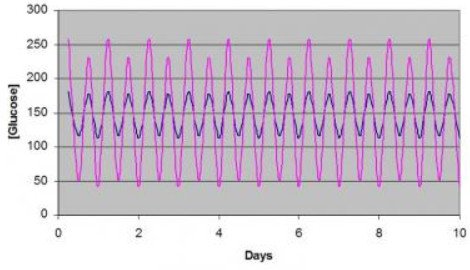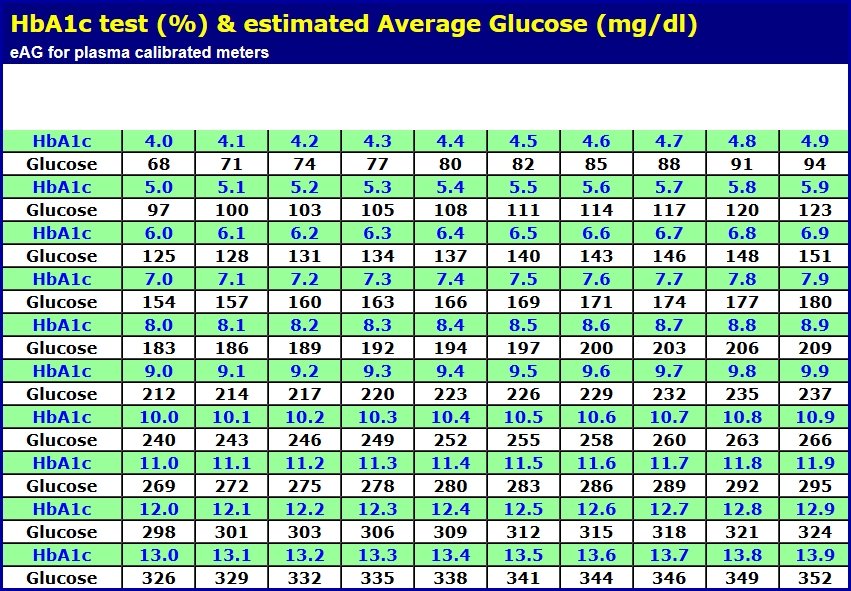What is Hemoglobin A1c (HbA1c)
Red Blood Cells (RBC) have a lifespan of about 120 days and part of their job is to carry hemoglobin. Hemoglobin is a protein which carries oxygen through the body.
It is also the protein that glucose attaches to. Hemoglobin A1c testing reflects the amount of glucose concentration over the life of the RBC. Basically, it shows the attachment of glucose to hemoglobin. (1-9)
It is the diagnostic test which is preferred for proper diagnosis of diabetes mellitus. (1) It can be used with Type I as well as Type II diabetes. (2)All manufacturers of testing equipment have standards to comply with, therefore all A1c testing is the same and acceptable. (7)
Although it gives an accurate overview of the past few months of glucose level it does not show theups and downs of the glucose level throughout the day. The graph below shows patients with similar A1c counts but represents great differences in the control of glucose levels throughout the day. (2)

Image source : medscapestatic.com(1)
There are various ways your doctor can write the name of this test when prescribing. These include: A1c, HbA1c, glycated hemoglobin test, or glycol hemoglobin test. (2)
Typical A1c results have a range of error including 0.5%. (7)
What are Normal HbA1c levels (Chart) ?
- The results are reflected as a percentage. Higher percentages show that a patient has high glucose levels and low percentages show a history of low glucose levels.
- Average level goals should be under 5.7% for diabetic patients. (2) Reaching this goal may take several months depending on compliance and prescriptions. (3)
- For non-diabetic patients 4-6% is normal. (3)
* This chart is only for reference purpose, any diagnosis must be made by a medical professional..
| Diagnosis* | A1C Level |
|---|---|
| Normal | below 5.7 percent |
| Diabetes | 6.5 percent or above |
| Pre-diabetes | 5.7 to 6.4 percent |
(source : https://www.niddk.nih.gov/health-information/diabetes/diagnosis-diabetes-prediabetes/a1c-test)

 (Chart reference : http://www.diabeteschart.org)
(Chart reference : http://www.diabeteschart.org)
What is Diabetes and should I be tested?
a. In a patient with diabetes, their glucose levels are not stable due to one of two reasons
- Because their cells cannot obtain the glucose needed due to lack of insulin secretion. This is considered Type I diabetes.
- Because the cells in the body cannot respond to insulin secreted. This is Type II diabetes(3)
b. The normal process of blood glucose and insulin secretion cause regular increase and a decrease in blood glucose during the day. Before eating your blood glucose levels are usually lower. After you eat the level of glucose rises up as your food is being digested.
Then it slowly lowers again due to the release of insulin from the pancreas. In diabetic patients, this process is altered. (2)
c. This test helps physicians to see how stable the blood glucose levels have been in an individual. The test can be compared to the physician seeing the glucose value during each day in a few months’ time span.
This knowledge can help your physician know if you have been controlling your glucose level, which is important in the prevention of secondary diagnosis related to diabetes.
d. Your physician may prescribe Hemoglobin A1c testing on a regular basis.(2) For newly diagnosed patients or those trying to get their blood glucose under control, testing may be done every 3 months. For those who have a better control of their blood glucose levels may only be tested once or twice a year.(4)
For those who get tested and show pre-diabetes, it is suggested they get rechecked every 2 years. Those who show pre-diabetes are most likely to be diagnosed within 10 years. (7)
Is there anything that can alter test results?
- Anemia, no matter the cause, may affect test results because anemia is specifically related to the hemoglobin.
- Some dietary supplements can affect the outcome of A1c. Be sure to alert your doctor if you are taking any vitamins, minerals, or herbals substances.
- Patients with a history of high cholesterol levels, or liver and kidney disease should alert their physician in case there are alterations to their test results. (4)
Why is getting A1c testing important?
It has been proven that diabetic patients with higher A1c levels have a greater risk of secondary diagnosis related to diabetes. This diagnosis can include and are not limited to the following:
- Problems associated with small blood vessels
- Heart issues
- Neurological issues
- Eye problems
- Kidney issue (5)
How is it tested and what do I need to do?
- Preparation for the test is not needed. The only way to prepare for good results is to do your best to control your blood glucose level the full three months before the testing is done.
- This test is usually done in a lab, but you may be given a kit to do the test at home.
- In the case of venipuncture blood will be drawn from a vein using a needle and small blood vial. This will cause a small amount of pain or discomfort. The best practice for the patient is to not watch the stick in order to prevent further stress.
- In the case of a finger stick test a small pin type needle will be used to prick your finger in order to remove the amount of blood needed for the test. (6)
What is eAG?
eAG stands for estimated average glucose. This is a calculation made from the A1C which shows a more exact representation of daily levels.
This differs from the average glucose level given by your at home monitor. This is because most patients tend to take their glucose when they feel it’s low or before meals. Therefore the average given from the home monitor will not be accurate as the one taken at the time of your A1c.(8)
In conclusion
Hemoglobin A1c is an important laboratory study in the control of diabetic glucose levels. Being tested is highly recommended in order to prevent as many secondary effects of diabetes as possible. This test can assist you and your physician to see if any new lifestyle changes should be made.
Be sure to always consult your physician when reviewing laboratory findings. Only with the assistance of your physician should you make changes in your diabetic treatment.
References :
- http://emedicine.medscape.com/article/2049478-overview
- https://www.niddk.nih.gov/health-information/health-topics/diagnostic-tests/a1c-test-diabetes/Documents/A1C_Test_DM_508.pdf
- http://bd.com/mx/diabetes/main.aspx?cat=3258&id=6976
- http://www.webmd.com/diabetes/guide/glycated-hemoglobin-test-hba1c
- http://bd.com/mx/diabetes/main.aspx?cat=3258&id=62995
- https://medlineplus.gov/ency/article/003640.htm
- https://www.niddk.nih.gov/health-information/diabetes/diagnosis-diabetes-prediabetes/a1c-test
- http://www.diabetes.org/living-with-diabetes/treatment-and-care/blood-glucose-control/a1c/
- http://dmsjournal.biomedcentral.com/articles/10.1186/s13098-016-0168-y

